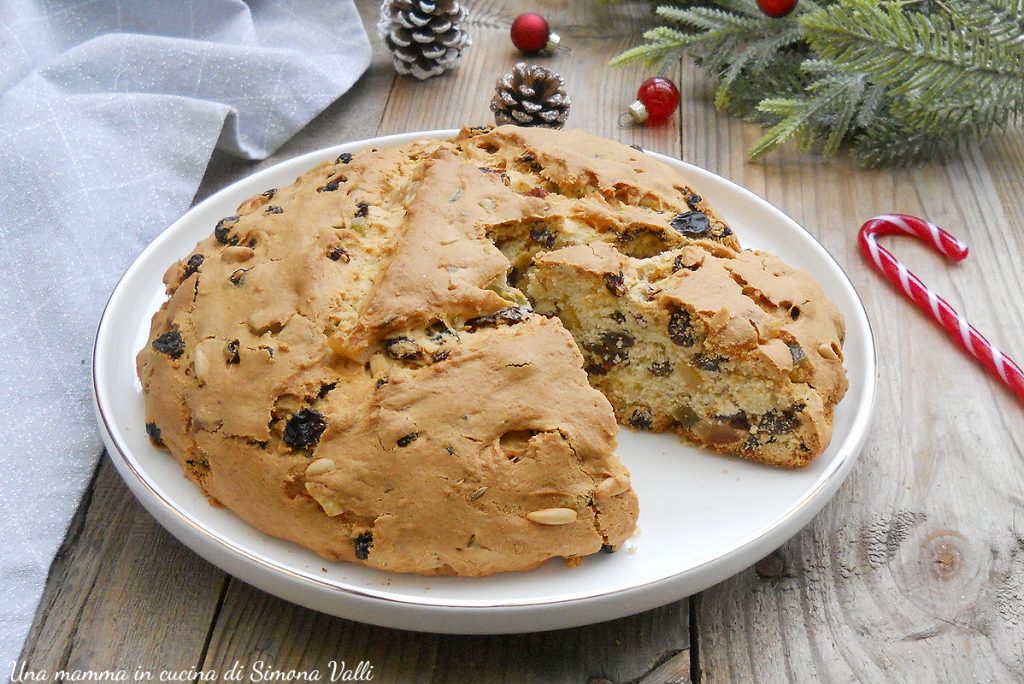The low Genoese pandolce is an ancient Ligurian dessert typical of the Christmas holidays, consisting of a very crumbly dough similar to a shortcrust pastry enriched with raisins, candied fruits, pine nuts, fennel seeds, aromas, and liqueur. In the past, it was only prepared during the holidays, but today it is consumed year-round, the same fate that has also befallen some of our desserts like the Christmas pinza and the San Giuseppe ravioli.
Like many traditional desserts, the Genoese pandolce has a more or less certain history; while some trace its origins back to ancient Persia, others say it was created in the 1500s by great pastry chefs who participated in a contest organized by Andrea Doria, who requested a rich bread that would represent Genoa and could be stored for long periods to face sea voyages.
What is certain is that this dessert originated a long time ago; initially, it was a sweet bread based on sourdough, honey, eggs, flour, fennel seeds, and a little oil. It was kneaded by housewives, left to rise with care, and baked in the home oven or village oven. Over time, it has been enriched with candied fruit and pine nuts, while honey and oil have been replaced by sugar and butter.
The pandolce is made in two versions, one high, soft with sourdough or brewer’s yeast, and a low one, the “ancient Genoa pandolce,” which is prepared in very little time and rises thanks to instant baking powder. Today, I will share the recipe for the low pandolce.
I made it for the first time thanks to the recipe found in the monthly magazine “la Cucina Italiana”, and since then, I always prepare it at Christmas with a few small modifications. It is an easy dessert to make but truly delicious and perfect to give as a gift along with Christmas cookies.
If you like, you can try other traditional Christmas desserts:

- Difficulty: Easy
- Cost: Expensive
- Preparation time: 20 Minutes
- Portions: 8 People
- Cooking methods: Electric oven
- Cuisine: Italian
- Seasonality: Christmas
- Energy 376.89 (Kcal)
- Carbohydrates 69.44 (g) of which sugars 41.77 (g)
- Proteins 5.68 (g)
- Fat 10.67 (g) of which saturated 5.34 (g)of which unsaturated 4.68 (g)
- Fibers 2.07 (g)
- Sodium 61.94 (mg)
Indicative values for a portion of 100 g processed in an automated way starting from the nutritional information available on the CREA* and FoodData Central** databases. It is not food and / or nutritional advice.
* CREATES Food and Nutrition Research Center: https://www.crea.gov.it/alimenti-e-nutrizione https://www.alimentinutrizione.it ** U.S. Department of Agriculture, Agricultural Research Service. FoodData Central, 2019. https://fdc.nal.usda.gov
Ingredients
- 2 1/2 cups all-purpose flour
- 1 3/4 cups raisins
- 1/2 cup candied orange peel
- 1/4 cup candied citron
- 6 tbsp butter
- 1/2 cup sugar
- 2 tsp baking powder
- 1/4 cup pine nuts
- 1/4 cup milk
- 1 tsp fennel seeds
- 1 egg (medium)
- 1 tbsp marsala
- 1 tbsp orange blossom water (I substitute with rum)
- 1 tsp lemon zest (grated)
- 1 pinch salt
Tools
- 1 Bowl large
- 1 Scale
- 2 Small bowls
- 1 Pastry board
- 1 Baking sheet
- Parchment paper
- 1 Hand whisk
Procedure
Wash the raisins under running water, place them in a small bowl, and cover with lukewarm water. Let them soften for 20 minutes. After soaking, drain the water and pat them dry with paper towels.
Cut the candied fruit into small cubes.
Grate the lemon zest.
Sift the flour with the baking powder, and add the salt.
Cut the butter into cubes and place it in the large bowl, leaving it at room temperature for 20 minutes.
Transfer the candied fruit cubes to a bowl, add the softened raisins, pine nuts, and fennel seeds. Set aside.
Pour the sugar into the bowl with the butter and mix with a hand whisk. Add the egg and incorporate. Add the milk, marsala, orange blossom water, and lemon zest. Mix the batter well.
Gradually add the sifted flour with the baking powder, and when fully incorporated, add the inclusions (candied fruit with raisins, pine nuts, and fennel seeds) and mix quickly.
Transfer the dough to the floured pastry board, briefly knead it by hand, using a little flour if necessary to distribute the inclusions evenly. Form a dough ball.
Place it on the baking sheet lined with parchment paper. Flatten slightly with your hands to form a disc 1.5-2 inches thick. Use a sharp blade to make the characteristic triangle on the surface.
Bake the cake in a preheated static oven at 340°F for 45/50 minutes. It should be golden but soft. Use a toothpick to check the doneness.
Remove the baking sheet from the oven and let the cake cool before transferring it to a tray.
The low Genoese pandolce is ready to enjoy.
Tips
Storage
The low Genoese pandolce can be stored for 1 month wrapped in the appropriate food wrap.
***********************
For tips on making the recipes, contact me on FACEBOOK and, if you like, follow me on INSTAGRAM
Send me your photos, I will be happy to share them on my social media

